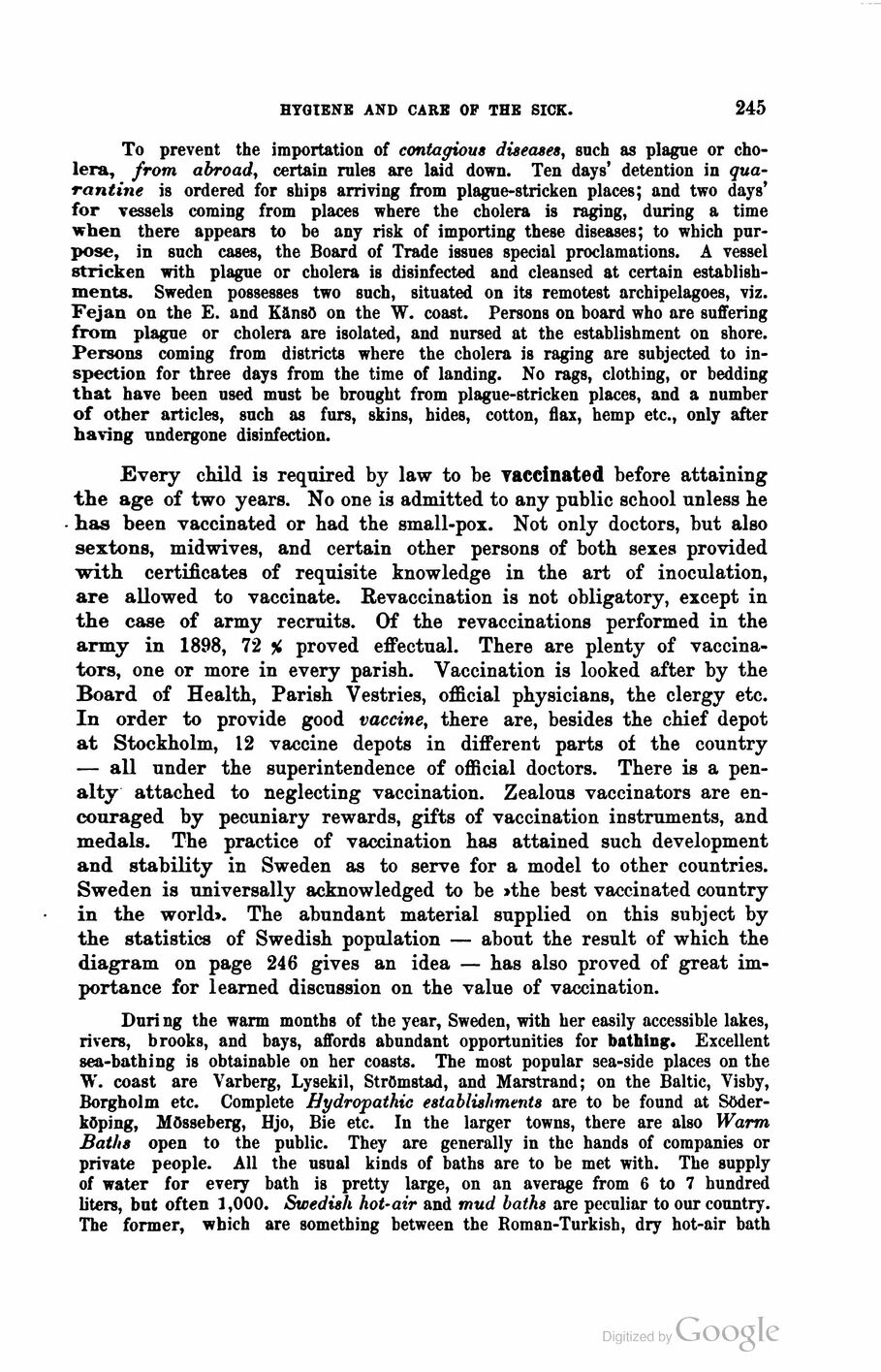
Full resolution (JPEG) - On this page / på denna sida - First part - III. Constitution and Administration - 2. State Administration - Hygiene and care of the sick, by C. Waller, M. D., Director of the Hålahult Sanatory, C. Runborg, M. D., Stockholm, and G. Schuldheis, M. D., Member of the Royal Medical Depart., Stockholm

<< prev. page << föreg. sida << >> nästa sida >> next page >>
Below is the raw OCR text
from the above scanned image.
Do you see an error? Proofread the page now!
Här nedan syns maskintolkade texten från faksimilbilden ovan.
Ser du något fel? Korrekturläs sidan nu!
This page has never been proofread. / Denna sida har aldrig korrekturlästs.
hygiene and care op the sick.
245
To prevent the importation of contagious diseases, such as plague or
cholera, from abroad, certain rules are laid down. Ten days’ detention in
quarantine is ordered for ships arriving from plague-stricken places; and two days’
for vessels coming from places where the cholera is raging, during a time
when there appears to be any risk of importing these diseases; to which
purpose, in such cases, the Board of Trade issues special proclamations. A vessel
stricken with plague or cholera is disinfected and cleansed at certain
establishments. Sweden possesses two such, situated on its remotest archipelagoes, viz.
Fejan on the E. and Känsö on the W. coast. Persons on board who are suffering
from plague or cholera are isolated, and nursed at the establishment on shore.
Persons coming from districts where the cholera is raging are subjected to
inspection for three days from the time of landing. No rags, clothing, or bedding
that have been used must be brought from plague-stricken places, and a number
of other articles, such as furs, skins, hides, cotton, flax, hemp etc., only after
having undergone disinfection.
Every child is required by law to be vaccinated before attaining
the age of two years. No one is admitted to any public school unless he
has been vaccinated or had the small-pox. Not only doctors, but also
sextons, midwives, and certain other persons of both sexes provided
with certificates of requisite knowledge in the art of inoculation,
are allowed to vaccinate. Revaccination is not obligatory, except in
the case of army recruits. Of the revaccinations performed in the
army in 1898, 72 % proved effectual. There are plenty of
vaccinators, one or more in every parish. Vaccination is looked after by the
Board of Health, Parish Vestries, official physicians, the clergy etc.
In order to provide good vaccine, there are, besides the chief depot
at Stockholm, 12 vaccine depots in different parts of the country
— all under the superintendence of official doctors. There is a
penalty attached to neglecting vaccination. Zealous vaccinators are
encouraged by pecuniary rewards, gifts of vaccination instruments, and
medals. The practice of vaccination has attained such development
and stability in Sweden as to serve for a model to other countries.
Sweden is universally acknowledged to be »the best vaccinated country
in the world». The abundant material supplied on this subject by
the statistics of Swedish population — about the result of which the
diagram on page 246 gives an idea — has also proved of great
importance for learned discussion on the value of vaccination.
Duri ng the warm months of the year, Sweden, with her easily accessible lakes,
rivers, brooks, and bays, affords abundant opportunities for bathing. Excellent
sea-bathing is obtainable on her coasts. The most popular sea-side places on the
W. coast are Varberg, Lysekil, Strömstad, and Marstrand; on the Baltic, Visby,
Borgholm etc. Complete Hydropathic establishments are to be found at
Söderköping, Mösseberg, Hjo, Bie etc. In the larger towns, there are also Warm
Baths open to the public. They are generally in the hands of companies or
private people. All the usual kinds of baths are to be met with. The supply
of water for every bath is pretty large, on an average from 6 to 7 hundred
liters, but often 1,000. Swedish hot-air and mud baths are peculiar to our country.
The former, which are something between the Roman-Turkish, dry hot-air bath
<< prev. page << föreg. sida << >> nästa sida >> next page >>